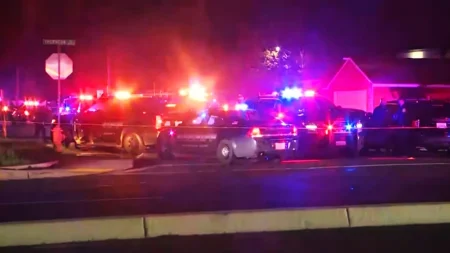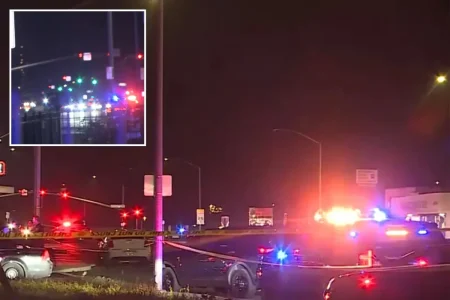Russia Escalates Conflict with Widespread Missile and Drone Strikes Across Ukraine
Major Urban Centers Bear Brunt of Renewed Assault as International Concerns Mount
In a significant escalation of hostilities that has drawn sharp international condemnation, Russian forces launched a coordinated barrage of missiles and drones targeting multiple Ukrainian population centers on Thursday. The widespread assault struck the capital city of Kyiv along with major metropolitan areas Dnipro and Kharkiv, while also impacting several smaller municipalities across the country. The attacks represent one of the most comprehensive bombardments in recent months, underscoring the continuing intensity of a conflict that has now extended well beyond initial expectations.
Ukrainian air defense systems were activated shortly after 3 a.m. local time as radar detected incoming projectiles approaching from multiple directions, according to Defense Ministry officials. In Kyiv, residents were jolted awake by air raid sirens followed by several loud explosions that reverberated through the capital’s central districts and suburbs. “The building shook like we were experiencing an earthquake,” recounted Olena Petrenko, 42, who lives in an apartment complex in Kyiv’s Shevchenkivskyi district. “We’ve unfortunately become accustomed to the routine – grab essential documents, water, and rush to the shelter.” Mayor Vitali Klitschko reported through his Telegram channel that at least three residential buildings sustained damage, with emergency services working through the night to address fires and rescue efforts. Preliminary reports indicated at least twelve injuries in the capital, though officials warned these numbers could rise as rescue operations continue in damaged structures.
The industrial hub of Dnipro, situated along the Dnieper River in central Ukraine, experienced what local authorities described as a “massive combined attack” utilizing both cruise missiles and Iranian-designed Shahed drones. The city’s critical infrastructure was specifically targeted, resulting in widespread power outages affecting approximately 40% of the metropolitan area. Valentyn Reznichenko, head of the Dnipropetrovsk Regional Military Administration, confirmed strikes had damaged a power substation and several manufacturing facilities that had been repurposed for military production. “This appears to be a deliberate attempt to cripple both civilian infrastructure and defense capabilities simultaneously,” Reznichenko stated during an emergency briefing. The timing of the attacks – occurring during pre-dawn hours when energy usage is typically lower – suggested a tactical approach aimed at limiting immediate humanitarian impact while achieving strategic military objectives, according to security analysts monitoring the situation.
In northeastern Ukraine, the city of Kharkiv suffered perhaps the most intensive bombardment of the coordinated assault. Located just 40 kilometers from the Russian border, Ukraine’s second-largest city has remained a frequent target throughout the conflict due to its strategic importance and proximity to Russian territory. Thursday’s attack featured what Ukrainian military officials identified as a combination of S-300 missiles, normally used for air defense but repurposed for ground attacks, alongside newer Iskander-M ballistic missiles known for their accuracy and ability to evade interception. Kharkiv Regional Governor Oleh Synyehubov reported significant damage to the city’s transportation infrastructure, including a strike on a railway junction that had been crucial for evacuations and humanitarian aid deliveries. “This represents a clear attempt to further isolate our region and complicate both civilian movement and logistics,” Synyehubov explained. Medical facilities in Kharkiv reported treating over thirty casualties, with at least five individuals in critical condition following the attacks.
Smaller Communities Face Disproportionate Impact as Resources Stretch Thin
While major cities dominated headlines, several smaller municipalities experienced equally devastating impacts with potentially more severe long-term consequences due to limited emergency response capabilities. In Kramatorsk, a front-line city in the Donetsk region with a pre-war population of approximately 150,000, a missile strike destroyed a five-story apartment building, trapping multiple residents beneath the rubble. Local volunteer rescue teams worked alongside military units to conduct search operations with minimal specialized equipment. Similarly, the town of Nikopol near the Russian-occupied Zaporizhzhia Nuclear Power Plant reported heavy artillery shelling that damaged critical water supply infrastructure, creating an immediate humanitarian challenge for the community of approximately 100,000 residents. “The larger cities receive more attention and resources, but our smaller communities often face equally devastating attacks with significantly fewer resources to respond,” noted Iryna Vereshchuk, Ukraine’s Minister for Reintegration of Temporarily Occupied Territories.
The pattern and scope of Thursday’s attacks prompted immediate analysis from international security experts regarding Russian military strategy. “This appears to represent a shift toward more comprehensive infrastructure targeting ahead of winter,” explained Retired U.S. Army Colonel Jonathan Spencer, now with the Institute for Strategic Studies. “By conducting simultaneous strikes across geographically dispersed locations, Russian forces are attempting to overwhelm Ukraine’s air defense capabilities, which despite Western reinforcement remain limited in their ability to provide complete territorial coverage.” The attacks utilized approximately 75 missiles of various types alongside an estimated 35 drones, according to preliminary Ukrainian Defense Ministry assessments. While official figures indicated approximately 60% of the incoming projectiles were successfully intercepted, the volume and diversity of the assault allowed numerous strikes to reach intended targets. This approach demonstrates Russia’s continued adaptation to Ukrainian defensive capabilities, particularly following the integration of Western-provided air defense systems like the American NASAMS and German IRIS-T over recent months.
International response to the escalation was swift, with United Nations Secretary-General António Guterres condemning the attacks on civilian infrastructure as “unacceptable” and potentially constituting violations of international humanitarian law. The European Union announced an emergency meeting of its Foreign Affairs Council to discuss additional support packages for Ukraine’s energy infrastructure and air defense capabilities. U.S. President Biden characterized the strikes as “brutal and deliberate targeting of civilian infrastructure” and indicated that an additional military assistance package focused specifically on air defense would be announced within days. Meanwhile, humanitarian organizations including the International Committee of the Red Cross expressed grave concern about the approaching winter months, noting that damage to energy infrastructure combined with seasonal temperature drops creates particularly dangerous conditions for vulnerable populations. “These attacks will have cascading effects on heating, water purification, and medical services precisely when weather conditions make these services most critical,” warned ICRC Regional Director Florence Gillette.
As Ukraine conducts damage assessments and emergency repairs, the pattern of Thursday’s attacks raises significant questions about both immediate humanitarian needs and longer-term strategic implications of the conflict. With power generation capacity already reduced by approximately 40% from pre-war levels, additional damage to the energy grid creates compounding challenges that extend well beyond immediate casualties. The targeting of transportation infrastructure similarly complicates both civilian evacuations and military logistics at a crucial moment in the conflict. While international attention often focuses on territorial gains and losses along front lines, Thursday’s widespread attacks demonstrate that the war’s impact extends far beyond conventional battlefield metrics. For millions of Ukrainians across major cities and smaller communities alike, the sounds of air raid sirens and explosions have become an unwelcome reminder that civilian life remains directly impacted by a conflict showing few signs of resolution despite approaching its second winter.











